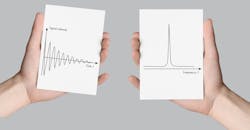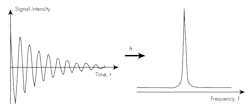Pulsed and continuous-wave (CW) signals serve numerous purposes in RF/microwave systems, including for voice, video, and data communications, electronic warfare (EW), surveillance, and radar. Pulsed signals remain powered for short periods of time, working with and without some form of modulation, such as amplitude, frequency, or phase modulation. CW signals remain on constantly and may be modulated to function as radars or in communications systems.
Both types of systems rely on many types of active and passive components for signal processing, which are characterized in different ways. However, each can effectively accomplish system-level functions in different shapes, sizes, and power levels, giving system designers a great deal of flexibility when setting performance goals.
A CW transmitter operates without interruption, as does its receiver. In contrast, a pulsed transmitter sends very short-duration signals that may even contain encoded information within the rise time of the pulsed signals. An extreme version of a pulsed system is a single-pulse system in which all critical data is carried by a single pulse. The operating tradeoffs between CW and pulsed systems start with the energy consumption, since the comparison is between amplifying continuous signals versus boosting the amplitudes of signals that only need to be processed part of the time.
Radar Applications
Pulsed signals are often associated with radar systems, but radar designs exploit both CW and pulsed signals, particularly commercial radars that are part of adaptive driver-assistance system (ADAS) equipment in newer automotive electronic safety systems. Pulsed radar systems transmit short pulses and calculate the distance to an illuminated target by measuring the time delay between a transmitted pulse and the returning reflected signal. A radar using CW signals, such as a frequency-modulated CW (FMCW) radar, transmits a steady stream of linearly modulated CW signals and calculates the distance from the transmitter to an illuminated target by determining the difference between the transmitted and received signal frequencies.
Both continuous-wave (CW) (left) and pulsed (right) signals are used throughout RF/microwave systems, such as communications and radar equipment, with differences in performance and behavior.
An FMCW radar system, with its continuous measuring signals, is capable of good range resolution, often as fine as 0.5 m. A pulsed radar system, on the other hand, is not quite as good on range resolution. It typically suffers a large “blind spot” in front of the radar of 50 m or more, resulting in poor range resolution. But for measuring long-range distance to a target, a pulsed radar system can produce the high signal power needed for high signal-to-noise ratio (SNR) and excellent range resolution.
Range and Detectability
A pulsed radar system typically provides greater measurement range compared to a CW radar, such as an FMCW radar system, with lower power consumption. A CW radar system delivers continuous updating of target information with higher measurement resolution than a pulsed radar system, and the lack of a minimum target distance. But due to those continuous signals, CW radar systems are more easily detected than pulsed radar systems, especially those with shorter duty cycles. CW radar systems are also more easily jammed than pulsed radar systems because the signal is more easily detected and characterized to know the type of jammer signal that’s needed to disrupt the system.
Systems operating with extremely short pulses, such as ultrawideband (UWB) radar systems, are very difficult to detect, especially when the signal levels are very low. A 24-GHz UWB pulsed radar system that operates with pulses that are only nanoseconds in duration may have a bandwidth that’s approximately 8 GHz wide, but the signal power required for radar operation is only about 4 mW. As a result, when a 24-GHz UWB radar system is transmitting, the pulsed power is not really much different than the surrounding environmental noise, and is extremely difficult to detect compared to a CW signal, such as used in FMCW radar systems.
An UWB pulsed radar system operates by generating a sequence of pulses of finite duration; during the times between each pulse, the transmitter is in an “off” or no-power state. Although the transmitter is not powered during this time, the receiver is powered and active so that it is able to detect any signals reflected by radar targets or returned by corresponding radio transmitters.
In a CW radar system, the transmitter and receiver are always operating. Therefore, adequate isolation must be achieved between the receiver and transmitter to prevent them from jamming each other. This is usually accomplished by using low transmit power levels in a CW radar system, although this also limits the distance across which a CW radar system can detect a target.
When a radar’s target is moving, the motion results in a Doppler shift in the frequency of the reflected pulse signals. As a result, a pulse Doppler radar can measure the relative speed of the illuminated target. But in an FMCW radar system, which uses the frequency of the reflected signals, the movement of the target causes additional frequency shift in these reflected FMCW radar signals, which can make it difficult to measure the distance to the illuminated target. By using different patterns of changing frequency, such as frequency decreasing or increasing with time, a radar system with FMCW signals can accurately measure the distance to a target.
For amplification, both solid-state and electron-tube amplifiers are used for pulsed and CW radar and communications systems. Typically more power is available for a pulsed amplifier than for the same-size unit operating at the same frequency and using CW signals. As an example, when comparing helix traveling-wave tubes (TWTs) from L-3 Electron Devices, which are designed for high power amplification at microwave frequencies but can also produce lots of excess heat due to the nature of their active devices, the difference in output power is quite dramatic. Such helix TWTs are used in electronic-countermeasures (ECM) systems, medium-range radar, and missile seekers, often in unmanned aerial vehicles (UAVs).
For instance, model L2086 is a robust TWT weighing 14 lbs. and producing 0.5 kW output power from 2 to 4 GHz. It’s capable of 30-dB gain while operating with CW signals. At more than twice the size, model L5714 is a helix TWT that weighs 30 lbs. but provides 40 times the output power over a slightly lower frequency range when operating with short pulses and a short duty cycle. It’s capable of 20 kW output power with 45-dB gain from 2.0 to 2.6 GHz when operating at a 0.4% duty cycle.
About the Author
Jack Browne
Technical Contributor
Jack Browne, Technical Contributor, has worked in technical publishing for over 30 years. He managed the content and production of three technical journals while at the American Institute of Physics, including Medical Physics and the Journal of Vacuum Science & Technology. He has been a Publisher and Editor for Penton Media, started the firm’s Wireless Symposium & Exhibition trade show in 1993, and currently serves as Technical Contributor for that company's Microwaves & RF magazine. Browne, who holds a BS in Mathematics from City College of New York and BA degrees in English and Philosophy from Fordham University, is a member of the IEEE.


